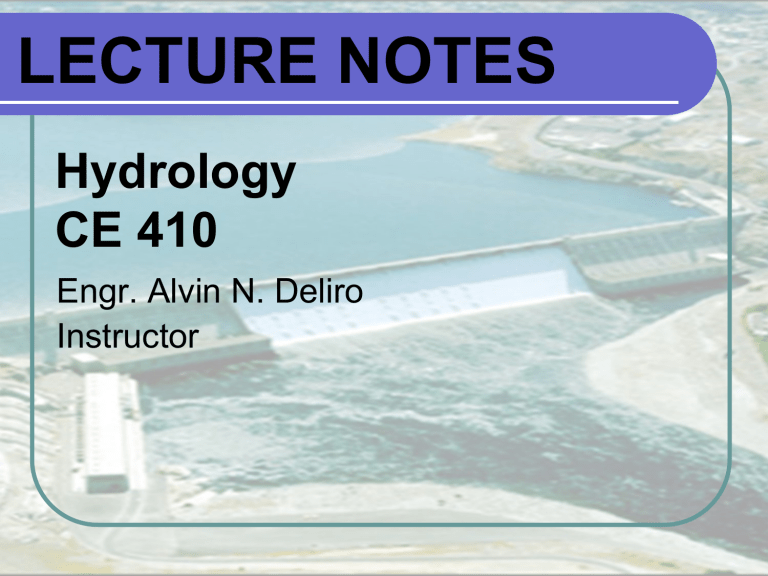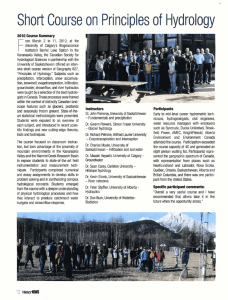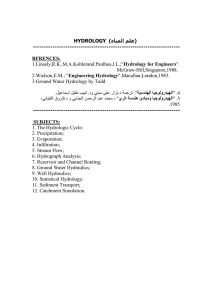
LECTURE NOTES Hydrology CE 410 Engr. Alvin N. Deliro Instructor Syllabus COPY WAS ISSUED AND DISCUSSED DURING ORIENTATION…. Course Description The course deals with the topics on water resources and losses; evaporation and infiltration effects on stream flow; hydrographs; precipitation, flood frequency, reservoirs, flood protection, water conservation, water supply management and recent technologies. The course describes the details in designing ground water wells and irrigation systems. Course Objective The course aims to develop the student’s ability to demonstrate specialized engineering knowledge in water engineering and hydrology and apply these knowledge in providing solutions to actual problems which pertains to water resource management as well as wastewater and environmental engineering Introduction to Hydrology Hydrology - It is the science that deals with the occurrence, circulation and distribution of water of the earth and earth’s atmosphere. - The science of water. Introduction to Hydrology The History of Hydrology Introduction to Hydrology Introduction to Hydrology 3000 BC- ground water development through wells was known to people of Indus Valley 4000 BC- A dam was built across the Nile river Introduction to Hydrology Application/ Uses of Hydrology Introduction to Hydrology Applications/Uses of Engineering Hydrology: 1. Hydrology is used to find out maximum probable flood at proposed sites e.g. Dams. 2.The variation of water production from catchments can be calculated and described by hydrology. 3.Engineering hydrology enables us to find out the relationship between a catchment's surface water and groundwater resource Introduction to Hydrology Applications/Uses of Engineering Hydrology: 4.The expected flood flows over a spillway, at a highway Culvert, or in an urban storm drainage system can be known by this very subject 5. Determining the water balance of a region. 6. Determining the agricultural water balance. 7. Mitigating and predicting flood, landslide and drought risk. 8. Real-time flood forecasting and flood warning. 9. In Designing irrigation schemes and managing agricultural productivity. 9. Designing riparian restoration projects relating to wetlands adjacent to rivers and streams. 9. Part of the hazard module in catastrophe modeling 10. Designing Bridges 10. Designing dams for water supply or hydroelectric power generation. 11. Designing sewers and urban drainage system. 12. Providing drinking water. 13. Analyzing the impacts of antecedent moisture on sanitary sewer systems. 14. Predicting geomorphologic changes, such as erosion or sedimentation. 15. Assessing the impacts of natural and anthropogenic environmental change on water resources. 16. Assessing contaminant transport risk and establishing environmental policy guideline In Engineering Hydrology we apply scientific knowledge and mathematical principles to solve water-related problems in society: problems of quantity, quality and availability. Mathematical models of all Hydrological phenomena are made. Introduction to Hydrology Hydrologic Cycle Describes the continuous movement of water on, above and below the surface of the Earth. The water moves from one reservoir to another. The water cycle involves the exchange of energy, which leads to temperature changes. The evaporative phase of the cycle purifies water which then replenishes the land with freshwater. Introduction to Hydrology The Process of Hydrological Cycle Introduction to Hydrology Introduction to Hydrology Physical Processes 1. Evaporation - The transformation of water from liquid to gas phases as it moves from the ground or bodies of water into the overlying atmosphere. Evapotranspiration- is the sum of evaporation and plant transpiration from the Earth's land and ocean surface to the atmosphere. Introduction to Hydrology Physical Processes 2. Condensation - The transformation of water vapor to liquid water droplets in the air, creating clouds and fog. Introduction to Hydrology Physical Processes 3. Precipitation – Condensed water vapor that falls to the Earth’s surface. Rain, snow, hail, fog, drip etc. Introduction to Hydrology Physical Processes 4. Transpiration - The release of water vapor from plants and soil into the air. Water vapor is a gas that cannot be seen. Introduction to Hydrology Physical Processes 5. Infiltration - The flow of water from the ground surface into the ground. Introduction to Hydrology Physical Processes 6. Run-off - It is the water flowing over the land making its way towards rivers, lakes, oceans etc. as surface or subsurface flow. Introduction to Hydrology Water Budget Equation Introduction to Hydrology CATCHMENT AREA - It is the area of the land draining into a stream or a water course at a given location - Drainage area or drainage basin; watershed Introduction to Hydrology Introduction to Hydrology Introduction to Hydrology Water Balance Introduction to Hydrology Watershed water balance P R G E T S Introduction to Hydrology Introduction to Hydrology EQUATION OF RAINFALLRUNOFF RELATIONSHIP Introduction to Hydrology Introduction to Hydrology Introduction to Hydrology Introduction to Hydrology Introduction to Hydrology Introduction to Hydrology Introduction to Hydrology








